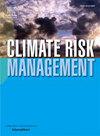Vulnerability and climate risk assessment in the Ecuadorian Amazon Region, based on ecological and socioeconomic infrastructures
IF 5
2区 环境科学与生态学
Q1 ENVIRONMENTAL SCIENCES
引用次数: 0
Abstract
Climate change is currently one of the greatest global concerns, as it increases the probability and magnitude of climate threats, putting population at risk, particularly in vulnerable regions such as the Ecuadorian Amazon Region (EAR). This area is known for its exceptional biodiversity and indigenous ethnic diversity but faces significant socioeconomic and environmental problems. The culturally diverse Amazonian tribes historically inhabit remote and difficult-to-access regions, which is reflected in low-level infrastructure and limited access to social services. These characteristics, combined with the lack of quantifiable data for the EAR, hinder the development of effective adaptation plans for climate hazards. To address this challenge, the present study evaluated climate risks under the current conditions and two Representative Concentration Pathways (RCPs) 4.5 and 8.5. The study followed the recommendations of the Intergovernmental Panel for Climate Change (IPCC) and Methods for the Improvement of Vulnerability Assessment (MOVE). Fuzzy logic was employed for the normalization and aggregation of multiple indicators classified under ecological and socioeconomic infrastructures. This approach allows the handling of scattered and complex information by generating partial or intermediate values, unlike classical logic, which is limited to binary outcomes (true or false). The main findings indicate that climate risk is high across the EAR in all scenarios, with particularly sever risks in the northern part of the region. Three consistent hotspots were identified in Lago Agrio, Shushufindi and Orellana, municipalities located within indigenous territories. This research provides a framework to support decision-making based on spatial analysis of climate-related information. We recommend incorporating ecological infrastructure into the development of holistic climate change adaptation plans, complementing traditional socio-economic assessments.
基于生态和社会经济基础设施的厄瓜多尔亚马逊地区脆弱性和气候风险评估
气候变化是目前全球最关注的问题之一,因为它增加了气候威胁的可能性和程度,使人口处于危险之中,特别是在厄瓜多尔亚马逊地区(EAR)等脆弱地区。该地区以其独特的生物多样性和土著民族多样性而闻名,但面临着重大的社会经济和环境问题。文化多样化的亚马逊部落历史上居住在偏远和难以进入的地区,这反映在基础设施水平低下和获得社会服务的机会有限。这些特点,再加上EAR缺乏可量化的数据,阻碍了制定有效的气候灾害适应计划。为了应对这一挑战,本研究评估了当前条件下的气候风险和两个代表性浓度路径(rcp) 4.5和8.5。该研究遵循了政府间气候变化专门委员会(IPCC)和改进脆弱性评估方法(MOVE)的建议。采用模糊逻辑对生态基础设施和社会经济基础设施分类的多个指标进行归一化和聚合。这种方法允许通过生成部分值或中间值来处理分散和复杂的信息,这与传统逻辑不同,后者仅限于二进制结果(真或假)。主要研究结果表明,在所有情景下,东亚地区的气候风险都很高,该地区北部的风险尤其严重。在土著领土内的拉戈阿格里奥、舒舒芬迪和奥雷拉纳市确定了三个一致的热点地区。本研究为支持基于气候相关信息空间分析的决策提供了一个框架。我们建议将生态基础设施纳入整体气候变化适应计划的制定,补充传统的社会经济评估。
本文章由计算机程序翻译,如有差异,请以英文原文为准。
求助全文
约1分钟内获得全文
求助全文
来源期刊

Climate Risk Management
Earth and Planetary Sciences-Atmospheric Science
CiteScore
8.20
自引率
4.50%
发文量
76
审稿时长
30 weeks
期刊介绍:
Climate Risk Management publishes original scientific contributions, state-of-the-art reviews and reports of practical experience on the use of knowledge and information regarding the consequences of climate variability and climate change in decision and policy making on climate change responses from the near- to long-term.
The concept of climate risk management refers to activities and methods that are used by individuals, organizations, and institutions to facilitate climate-resilient decision-making. Its objective is to promote sustainable development by maximizing the beneficial impacts of climate change responses and minimizing negative impacts across the full spectrum of geographies and sectors that are potentially affected by the changing climate.
 求助内容:
求助内容: 应助结果提醒方式:
应助结果提醒方式:


